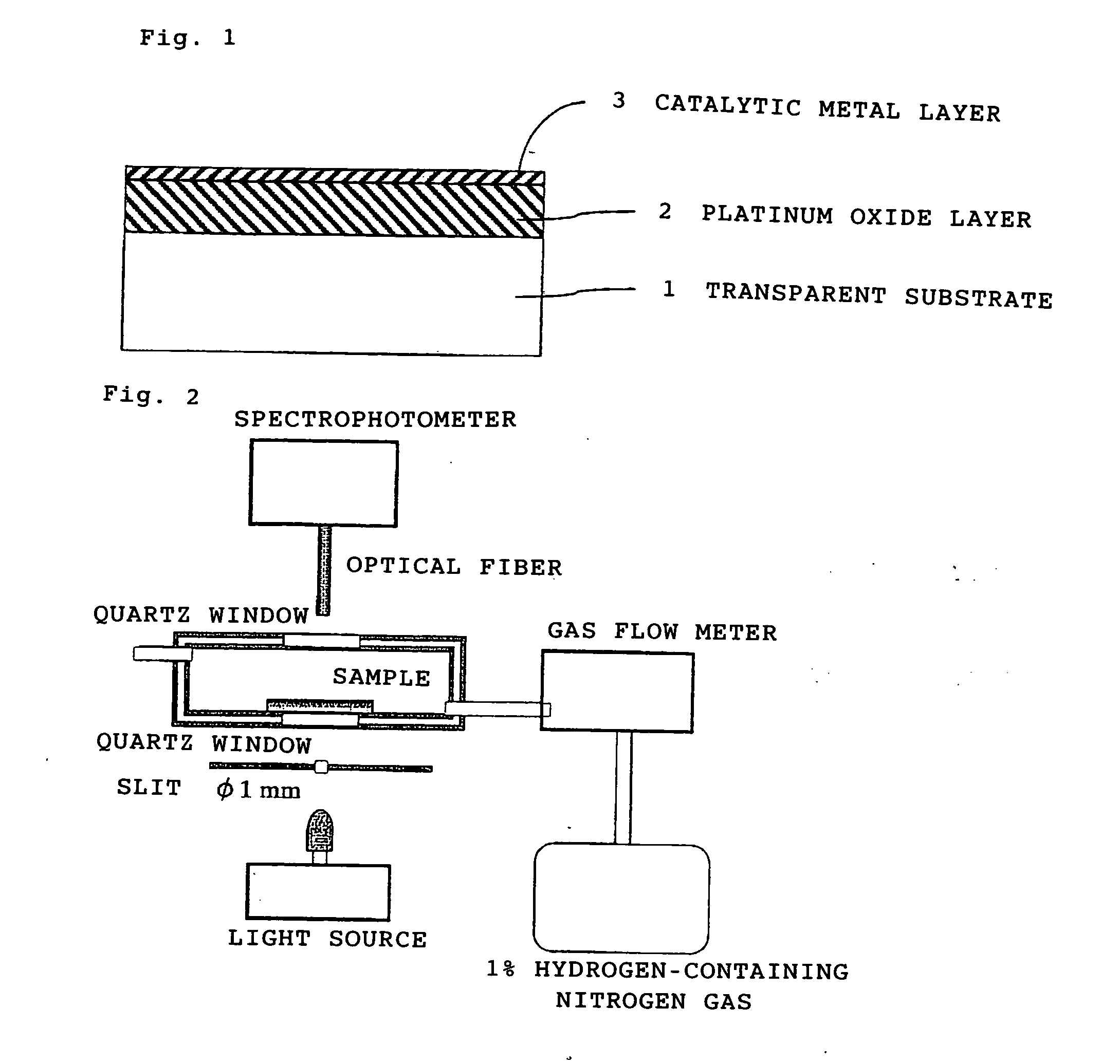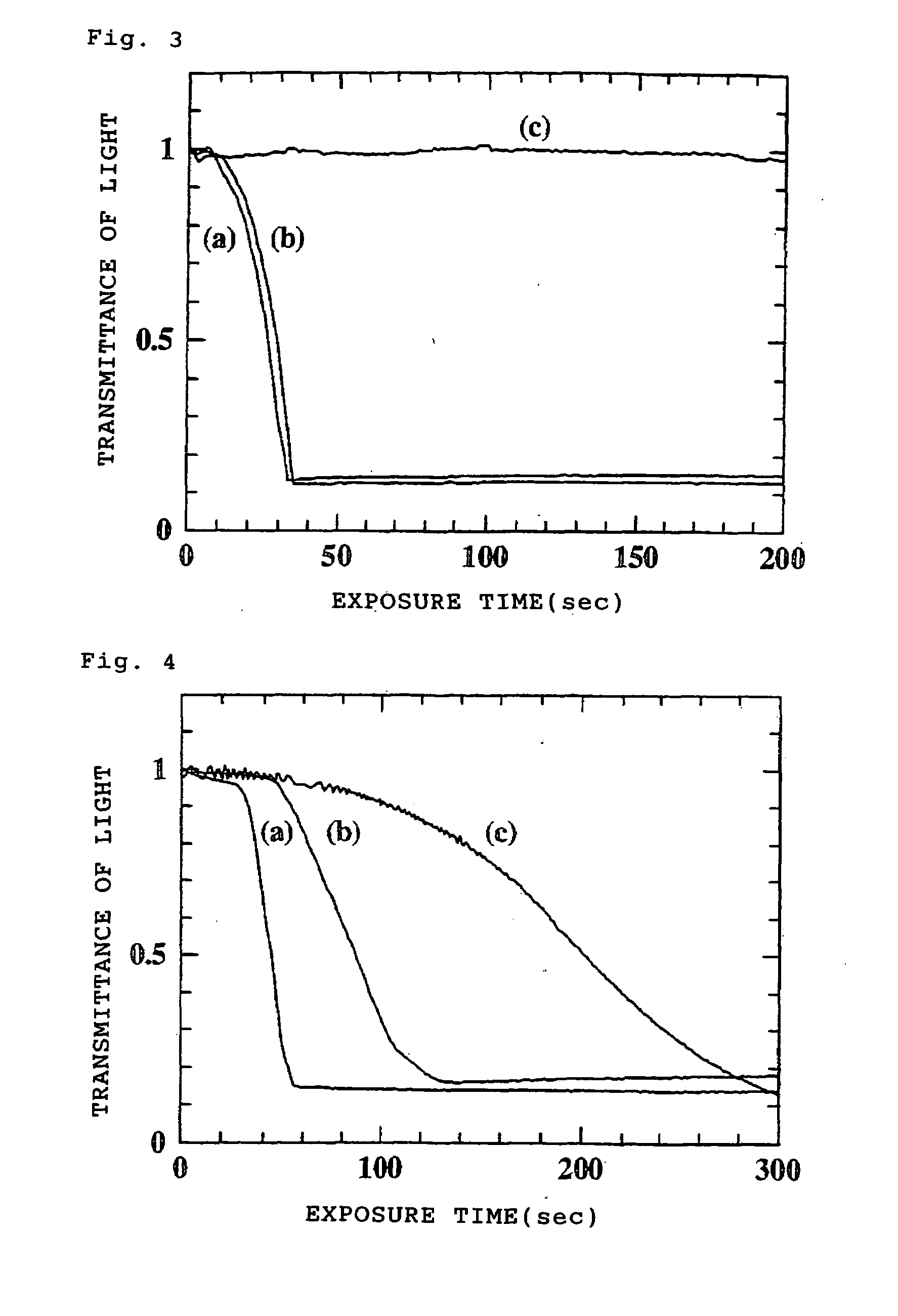Hydrogen gas detecting membrane
a hydrogen gas and detection membrane technology, applied in the direction of instruments, chemical methods analysis, analysis using chemical indicators, etc., can solve the problems of posing a problem, combustible gas fuel, safety problems, etc., and achieve the effect of satisfying reproducibility
- Summary
- Abstract
- Description
- Claims
- Application Information
AI Technical Summary
Benefits of technology
Problems solved by technology
Method used
Image
Examples
example 1
[0030]A thin platinum oxide film was prepared on the surface of a quartz substrate of 0.5 mm in thickness with the use of high frequency sputtering. In forming the film, a platinum disk with a diameter of 50 mm, a thickness of 1 mm, and purity of 99.99% was used as a target, and the platinum target was sputtered at an electric power of 50 W in an argon-oxygen mixed gas (0.315 Pa) atmosphere having an argon gas partial pressure of 0.155 Pa and an oxygen gas partial pressure of 0.160 mPa, to perform platinum oxide film formation on the quartz substrate at room temperature (20° C.). The thickness of the platinum oxide film was about 296 nm in a film formation time of 10 minutes.
[0031]On this thin platinum oxide film, palladium as a catalyst was deposited in a thickness of about 15 nm by use of the high frequency sputtering method. For the sputtering of palladium, a metallic palladium disk with a diameter of 50 mm, a thickness of 5 mm and purity of 99.99% was used as a target, and film ...
example 2
[0035]Platinum was deposited in a thickness of about 15 nm at room temperature (20° C.) on a thin platinum oxide film prepared on a quartz substrate in the same manner as in Example 1. Changes over time in the transmittance of light due to hydrogen were measured as in Example 1. The results of the measurements are shown by the curve (b) in FIG. 3.
[0036]It can be confirmed that with the platinum oxide film having platinum deposited thereon, as the time of exposure to the hydrogen gas increased, the transmittance of light decreased. This outcome shows that even when platinum is used as the catalytic metal, coloration of the platinum oxide layer occurs in response to the hydrogen gas, indicating that the hydrogen gas is detectable.
example 3
[0039]Using sapphire, polyethylene, and polyethylene terephthalate (PET) as substrate materials, thin platinum oxide films were prepared under the same conditions as in Example 1. These platinum oxide films were measured for changes over time in the transmittance of light due to hydrogen as in Example 1. On each platinum oxide film, palladium was deposited as a catalytic metal in a thickness of about 15 nm.
[0040]Curves (a), (b) and (c) in FIG. 4 show the results of measurements of the platinum oxide films formed on the sapphire substrate, the polyethylene substrate, and the PET substrate, respectively. The platinum oxide films formed on any of the substrates were confirmed to be colored in response to hydrogen. Thus, it can be found that inorganic materials such as sapphire, and polymeric materials such as PET, which allow passage of light in the visible light region, can be utilized as substrates for hydrogen gas detecting membranes.
PUM
| Property | Measurement | Unit |
|---|---|---|
| thickness | aaaaa | aaaaa |
| thickness | aaaaa | aaaaa |
| temperature | aaaaa | aaaaa |
Abstract
Description
Claims
Application Information
 Login to View More
Login to View More - R&D
- Intellectual Property
- Life Sciences
- Materials
- Tech Scout
- Unparalleled Data Quality
- Higher Quality Content
- 60% Fewer Hallucinations
Browse by: Latest US Patents, China's latest patents, Technical Efficacy Thesaurus, Application Domain, Technology Topic, Popular Technical Reports.
© 2025 PatSnap. All rights reserved.Legal|Privacy policy|Modern Slavery Act Transparency Statement|Sitemap|About US| Contact US: help@patsnap.com



